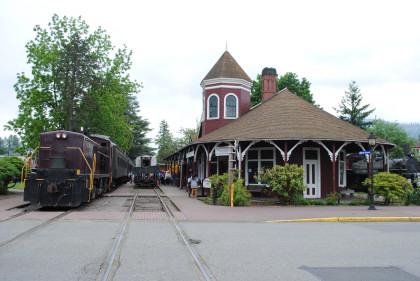
I did not have much holiday time in 2011, as I had only been at my new job less than a year, and would be taking a few days off the following month for Train Festival 2011. As such, the first National Railway Historical Socity convention event that I participated in was the visit to the Northwest Railway Museum located at Snoqualmie.
The convention was based in Tacoma and there were going to be motor coaches travelling to Snoqualmie. But as I lived north in Lynnwood, Chris Guenzler and I set off for Snoqualmie early in the morning (Bob had another commitment). I turned the wrong way on State Route 522, but it did not matter, for southbound was the route to Woodinville and the Eastside Freight Railroad.
Eastside Freight Rail operates on the Eastside Railroad (officially referred to as the Woodinville Subdivision) that runs in a generally north- south direction through Seattle's heavily populated and rapidly growing eastern suburbs as well as through the southern third of Snohomish County. It is the only remaining north-south rail line east of the Cascades other than Burlington Northern's heavily used and vulnerable main line through downtown Seattle. The Eastside railroad begins south of Seattle in Tukwila, where it branches off from Burlington Northern's main line that connects Seattle and Tacoma. It then runs in a generally eastern direction to downtown Renton, after which it turns north for the remainder of its route. The southern half of the main line runs roughly parallel to both the eastern shore of Lake Washington and the I-405 freeway. It passes through or near most major destinations on the Eastside, including downtown Bellevue, which has the second largest urban core in Washington State.
The siding sign for Woodinville.
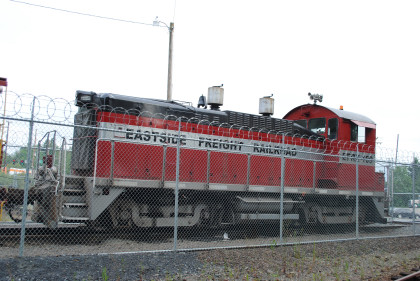
EFRX SW1200 109 (ex. Tacoma Rail 1204, exx. Tacoma Municipal Belt Line 1204, exxx. CEECO 207, nee Missouri Pacific 1191).
NPRX caboose 1103. I drove us to the museum, arriving a little before the convention motor coaches arrived, so had time to look around.
Northwest Railway Museum HistoryThe Northwest Railway Museum was founded in 1957 as the Puget Sound Railway Historical Association and is currently the largest and most comprehensive railroad museum in Washington State. It took its current name in September 1999. The mission of the organization is to develop and operate an outstanding railway museum where the public can see and understand the role of railroads in the development of the Pacific Northwest, and experience the excitement of a working railroad. The museum's collection also includes a variety of railway cars and locomotives that document that development of the railway in Washington from the 1880s through the 1960s, including the Messenger of Peace Chapel Car which is listed on the National Register of Historic Places. It also includes a 3,000-volume library and archives that focus on the history of railroads in the Northwest, and on technical and other engineering aspects of railroading. The Northwest Railway Museum also operates a heritage railroad called the Snoqualmie Valley Railroad. This five mile railway allows museum visitors to experience a train excursion aboard antique railroad coaches through the Upper Snoqualmie Valley. In August 2006, the Museum dedicated the new Conservation and Restoration Center, phase one of the Railway History Center.

The Snoqualmie Depot which has been restored to its turn-of-the-century grandeur, and functions as an operating train station. Museum visitors travelling on the Snoqualmie Valley Railroad can view the railroad history exhibits in the former gentlemen's waiting room and freight room. A railroad history-themed gift shop (The Depot Bookstore) is housed in the former ladies' waiting room. Public restrooms occupy a portion of the original freight room, and replace the privy originally located just to the east of the structure. The station was constructed by the Seattle, Lake Shore and Eastern Railway in 1890. Six years later, it was reorganized as the Seattle International Railway, and by 1901 the railway and the depot were absorbed into the Northern Pacific Railway. The Snoqualmie Depot remained in active service until the Burlington Northern Railroad absorbed the Northern Pacific in the 1970 merger with the Great Northern Railway, and in the mid-1970s began re-routing trains to Snoqualmie over the Milwaukee Road. At the time of its building, the Depot was unusually elaborate when considering the modest population of Snoqualmie. Yet through its years of service and multiple ownership changes, the Depot underwent so many renovations that it was no longer recognizable as a train station. In 1975, the Burlington Northern officially abandoned the line, and donated the depot building and several miles of track to the Northwest Railway Museum. The Snoqualmie Depot is listed on the National Register of Historic Places and is a City of Snoqualmie and King County Landmark.
Great Northern baggage car 485 (ex. BN work service 950190 1972-1986, exx. BN work service 968060 1972, exxx. BN baggage 485 1948-1970, exxxx. GN tourist-sleeper 1056 1941-1948, nee Pullman sleeper "Epicurius" 1921-1941). Retired in 1986 and purchased by the museum.
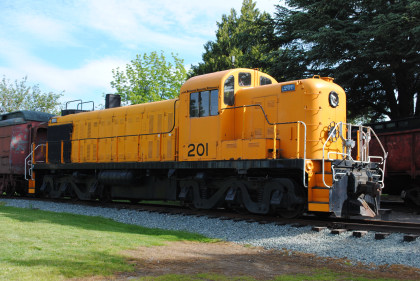
Kennecott Copper RSD-4 201.
The sign for RSD-4 201.
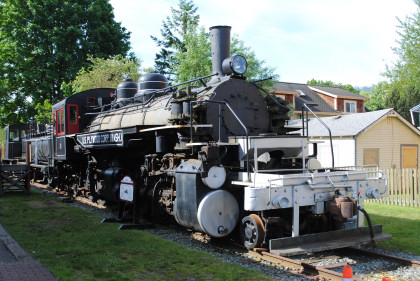
US Plywood 2-6-6-2 11 (ex. US Plywood Corp 11 (1953-1961), exx. Kosmos Timber 11 (1950-1953), exxx. M. Bloch & Co 1950, exxxx. Weyerhauser 5 (1939-1950), nee Ostrander Railway & Timber 7 (1926-1939). It was displayed at University of Washington in 1961 then in 1974, passed to Washington Parks & Recreation then leased to NWRM and pulled the museum's trains for several years. It steamed under on power to Kenmore and was last steam engine to operate in Seattle until the American Freedom Train in 1975.
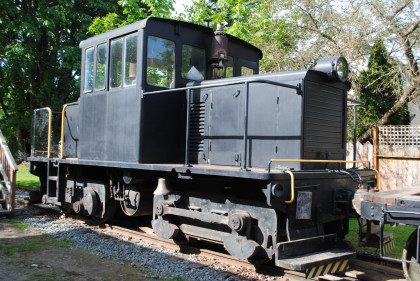
United States Army 44 ton switcher 7320.
USAX RS4TC 4012 (nee USAX 7320 1941). Transferred to the U.S. Navy in 1956 and used at Bremerton. Retired 1976 and acquired by the Northwest Railway Museum in 2001. This was the motive power for the convention train.
Our train at Snoqualmie.
The rear of our train, in the form of Oregon, Washington and Navigation cafe/observation 1590 built in 1913 (later Union Pacific 552). Given to Northwest Railway Museum in 1977.
The Snoqualmie Log Pavilion. This wheeled logging carriage is on display just down from the station. Although not part of the railway museum, it indicates the importance of the lumber industry to the town. During the 1850's, English settlers moved into the area that would become Snoqualmie and began farming, but others soon saw the commercial potential of the huge stands of fir, spruce, hemlock and cedar in the adjacent mountain forests. The first lumber mill was established at the mouth of Tokul Creek around 1872 by Watson Allen. Five years later, there were twelve logging operations on the Snoqualmie River and, within fifteen years, logging and mill work was employing one hundred and forty men and sending millions of board feet of lumber down the river. The Snoqualmie Falls Lumber Company (later the Weyerhaeuser Timber Company) opened a mill about a mile north of Snoqualmie in 1917, and the wheeled carriage is similar to one used at the mill to push 10-15 foot diameter logs through a massive bandsaw, cutting timbers for a variety of uses, from flooring to timber trestle bridges.
Explanatory plaque.
My ticket for the trip. We boarded the train and chose the combine, right beside the open baggage door, a perfect place to sit and enjoy the scenery and breeze this summer's day.
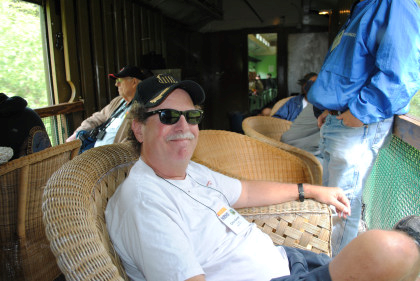
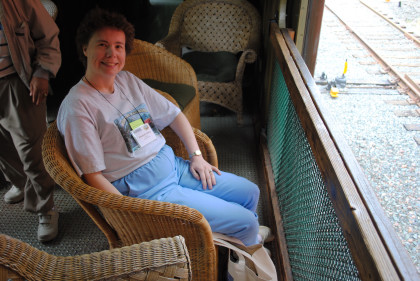
Chris and I enjoying the comfortable chairs and the ride.
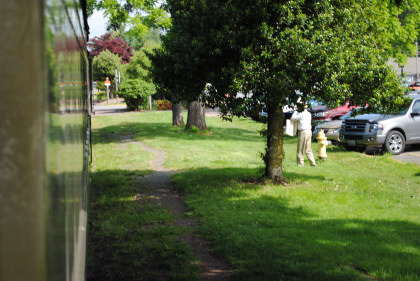
Making our way out of the Snoqualmie museum area.
Salish Lodge in the background with construction for the new hydro-electric power plant in the foreground.
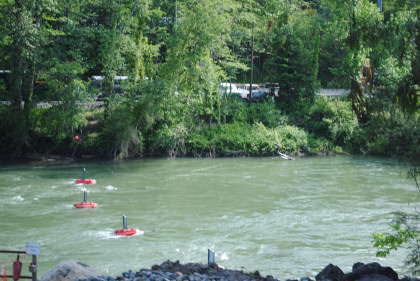
The Snoqualmie River ready to fall.
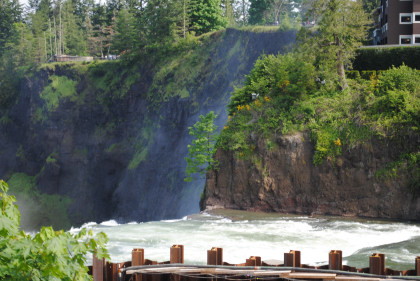
The Snoqualmie Falls from the top falling over.
The rapids of Snoqualmie Falls through the trees.
The Snoqualmie River.
The bridge in the foreground is made from flat cars.
Crossing the bridge as the train approaches North Bend.
The road bridge and the south fork of the Snoqualmie River.
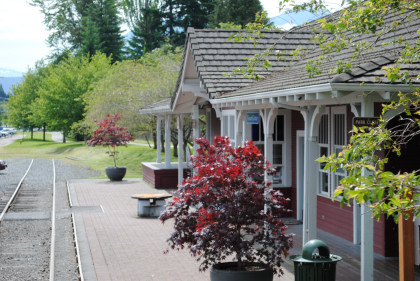
Passing the North Bend station, bound for the Railway History Train Centre.
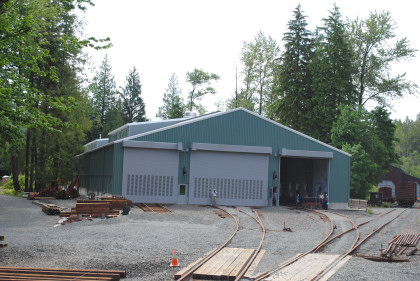
Our destination this fine June day.
Passing Weyerhauser H-12-44 1 at the restoration shop. It was used on the White River branch to haul lumber from Enumclaw to the interchange with the Northern Pacific. Retired in the mid 1970's, it was sold to Pacific Transportation Services and purchased by NWRM in 1987.
Close-up of the Fairbanks logo, the best I could do from a moving train. Upon arrival at North Bend, the passengers were split into coloured groups and taken on tours of the restoration shop and train shed. I had an opportunity to take photographs of the consist of our train.
Spokane, Portland and Seattle combine 272, built 1915 by Barney and Smith. Acquired from the Burlington Northern in 1977.
Spokane, Portland and Seattle wooden coach 213, built 1912 by Barney and Smith. NWRM acquired it in 1977 from a private owner.
Spokane, Portland and Seattle steel coach 276 built 1915 by Barney and Smith. It was purchased from the Burlington Northern in 1972.
Once inside the restoration shop, we walked through the interior of a coach undergoing extensive restoration.
Roof and panelling detail of the coach.
Exterior view.
Of great interest to everyone was the American Baptist Publication Society Chapel Car 5 "Messenger of Peace". Built in 1898 by Barney and Smith, it served the Baptist Publication Society, Baptist Home Mission Society and the Railroad YMCA for fifty years. This car was a feature exhibit at the Louisianna Purchase World Exposition in St Louis from April 30th to December 1st, 1904. It operated in at least eleven states and travelled extensively in the Pacific Northwest. It continued to serve the church until 1948 and was the last American Baptist chapel cars to be retired. Afterwards, it was used in several creative ways until 2006 including as a roadside diner and a seaside cottage. It had a significant impact on the lives of people throughout the Northwest and visited towns and villages in nearly every county in Washington. In 2007, it was donated and moved to the Northwest Railway Museum where it was undergoing an extensive renovation.
Rayonier gang motor car 21, acquired by NWRM in 1984.
From here, we made our way into the train shed.
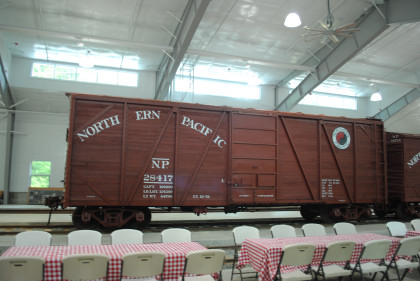
Northern Pacific Braced boxcar 28417.

Northern Pacific Braced boxcar 14794.
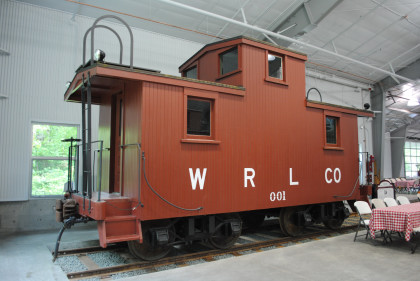
White River Lumber Company caboose 001 built in 1945 at Enumclaw, Washington and was a gift from Weyerhauser in 1973.
One of the volunteers giving a demonstration of track tools.
Track equipment inside the train shed.
Ballast spreader/time tamper. After a catered lunch, it was time for the return trip to Snoqualmie.

Our train and the Snoqualmie station. Before we left, we stopped at the line of stored locomotives along the road.
Western Steel Casting 35 ton switcher 7587 (nee US Army 7587) built by Plymouth in 1943. It was donated to the museum in 1985.
S.S. Agnew Lumber 3-truck Shay 1 (nee Eastern Railway Lumber Company 2) built 1904 by Lima. Last operated in 1951 and was given as a gift to NWRM in 1964.
Weyerhauser Timber 2-6-6-2 6 (nee Mud Bay Logging 8 1928). It was transferred from Mud Bay Logging to Weyerhaeuser's Klamath Falls, Oregon branch in 1940 and renumbered 6, then sold to the Puget Sound Railway Historical Association in 1965. It was sold in 2016 to the Black Hills Central Railroad in South Dakota where it was re-numbered 108 and is a sister to their 110.
Oregon Short Line 2-8-0 529 (ex. UP 529 1915, nee OSL 969 1903).
Ohio Match Company Heisler 4 used on their logging operations near Hayden Lake, Idaho. Known as the Burnt Cabin Railroad, this 25 mile logging railroad ran eastward from Garwood, past the north end of Hayden Lake, ending at the Burnt Cabin drainage. The engine was later sold to the National Pole and Treating Co. (NPT) for their lumber treating plant near Spokane and was re-numbered 2. NPT's name was changed to Minnesota & Ontario Paper Company in 1940. The steam engine last operated in 1958 and in 1967, the locomotive was purchased by the Northwest Railway Museum.
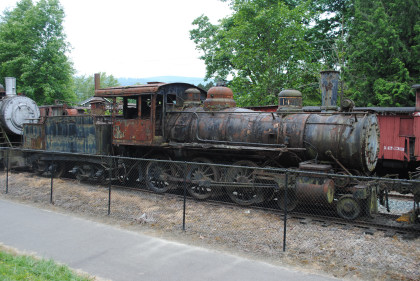
Canadian Colleries 4-6-0 14, built 1898 and spent its life working on Vancouver Island, hauling coal from mines on the island to a giant coal dock at the deepwater port of Union Bay on the east coast. In 1910, Canadian Collieries bought out the Union Collieries of British Columbia, owner of the mines, along with the railroad that served them, including 14 and another locomotive, 17. In 1960, both locomotives were sold to the Puget Sound Railway Historical Association.
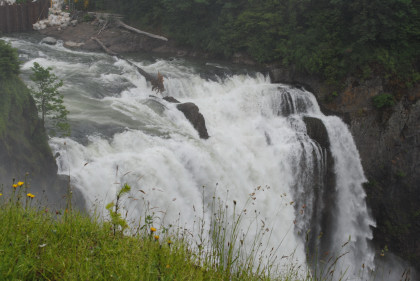
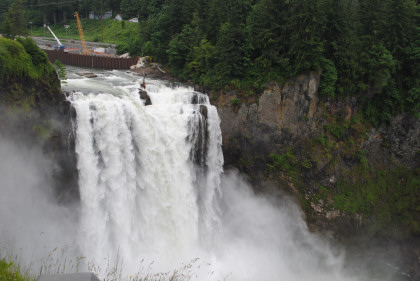

On the way out of Snoqualmie, we stopped at the famous Snoqualmie Falls before going to Carnation, for my first visit. But that is another travelogue.
| RETURN TO THE MAIN PAGE |